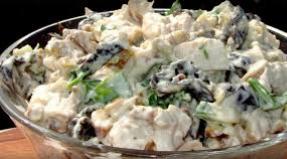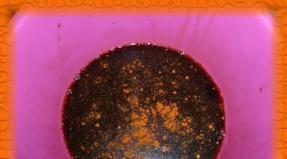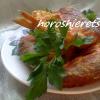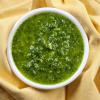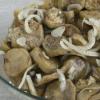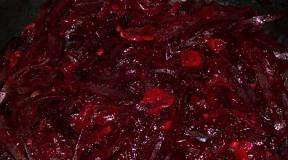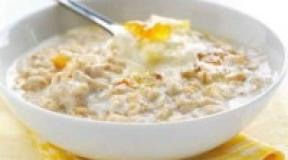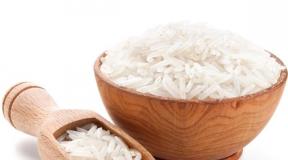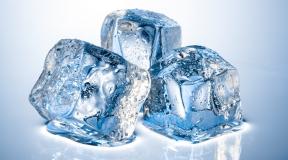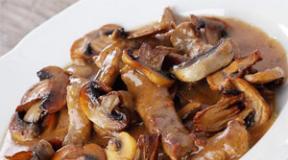Flow chart dishes potato soup. Changes occurring in the products during cooking. The name of the dish: Buckwheat porridge with milk
1.doc
FIRST MEALTECHNOLOGICAL CARD № 1
The name of the dish: Homemade pickle with meat
Weight of finished dish: 200
| Product Name | Gross weight | Net weight | Chemical composition | Calorie content |
||
| B | F | Have |
||||
| Beef 1 cat. | 40,0 | 30,0 | 5,58 | 4080 | 0,00 | 65,5 |
| Cabbage | 20,0 | 20,0 | 0,60 | 0,20 | 1,80 | 2,0 |
| Potatoes | 80,0 | 57,6 | 1,15 | 0,23 | 10,54 | 45,3 |
| Carrot | 10,0 | 8,0 | 0,10 | 0,01 | 0,76 | 2,7 |
| Onion | 10,0 | 8,4 | 0,12 | 0,00 | 0,89 | 3,4 |
| Pickles | 13,0 | 13,0 | 0,10 | 0,01 | 0,30 | 1,3 |
| Unsalted Peasant Oil | 20,0 | 20,0 | 0,02 | 1,45 | 0,03 | 13,2 |
| Drinking water | 140,0 | 140,0 | 0,00 | 0,00 | 0,00 | 0,00 |
| Total | 7,4 | 6,5 | 13,7 | 135,8 |
||
Collection of recipes 1983., Layout number 207
Put cabbage into boiling broth or water, bring to a boil, lay potatoes, and after 5-7 minutes, browned vegetables and stewed cucumbers.
^ TECHNOLOGICAL CARD № 2
The name of the dish: Bean soup with meat
Weight of finished dish: 200
| Product Name | Gross weight | Net weight | Chemical composition | Calorie content |
||
| B | F | Have |
||||
| Beef | 40,0 | 40,0 | 7,44 | 6,40 | 0,00 | 87,4 |
| Potatoes | 53,4 | 38,4 | 0,77 | 0,15 | 7,04 | 30,2 |
| Beans | 20,3 | 20,2 | 4,14 | 0,41 | 12,30 | 59,7 |
| Carrot | 10,0 | 8,0 | 0,10 | 0,01 | 0,76 | 2,7 |
| Onion | 10,0 | 8,4 | 0,12 | 0,00 | 0,89 | 3,4 |
| Peasant oil | 4,0 | 4,0 | 0,03 | 2,90 | 0,05 | 26,4 |
| Drinking water | 140,0 | 140,0 | 0,00 | 0,00 | 0,00 | 0,00 |
| Total | 12,6 | 9,9 | 21,0 | 209,8 |
||
Beans are sorted, washed, put in cold water (2-3 l per 1 kg) for 3 hours, then boiled in the same water without salt with the lid closed until softened. Beans are put in boiling broth, brought to a boil, potatoes are added, browned vegetables and cooked until ready.
^ TECHNOLOGICAL CARD № 3
The name of the dish: Potato soup with meat
Weight of finished dish: 200
| Product Name | Gross weight | Net weight | Chemical composition | Calorie content |
||
| B | F | Have |
||||
| Beef 1 cat. | 40,0 | 30,0 | 5,58 | 40,80 | 0,00 | 65,5 |
| Potatoes | 120,0 | 86,4 | 1,73 | 0,35 | 15,81 | 67,9 |
| Carrot | 10,0 | 80,0 | 0,10 | 0,01 | 0,76 | 2,7 |
| Onion | 10,0 | 80,4 | 0,12 | 0,00 | 0,89 | 3,4 |
| Pickles | 13,0 | 13,0 | 0,10 | 0,01 | 0,30 | 1,3 |
| Unsalted Peasant Oil | 20,0 | 2,0 | 0,02 | 1,45 | 0,03 | 13,2 |
| Drinking water | 140,0 | 140,0 | 0,00 | 0,00 | 0,00 | 0,00 |
| Total | 70,5 | 6,6 | 17,5 | 152,9 |
||
Collection of recipes 1983., Layout 215
Put potatoes in boiling broth or water, bring to a boil, add browned vegetables and boil until cooked.
Quality requirements:
Broth should be transparent. Vegetables retain the shape of the cut. Taste and aroma characteristic of the recipe products.
^
TECHNOLOGICAL CARD № 4
The name of the dish: Peasant soup with cereals (barley) with meat
Weight of finished dish: 200
| Product Name | Gross weight | Net weight | Chemical composition | Calorie content |
||
| B | F | Have |
||||
| Beef 1 cat. | 40,0 | 40,0 | 7,44 | 6,40 | 0,00 | 87,4 |
| Cabbage | 30,0 | 24,0 | 0,43 | 0,02 | 1,71 | 6,5 |
| Potatoes | 26,6 | 19,2 | 0,38 | 0,08 | 3,50 | 15,1 |
| Pearl barley | 8,0 | 8,0 | 0,74 | 0,09 | 5,40 | 25,6 |
| Carrot | 10,0 | 8,0 | 0,10 | 0,01 | 0,76 | 2,7 |
| Bow | 10,0 | 8,4 | 0,12 | 0,00 | 0,89 | 3,4 |
| Unsalted Peasant Oil | 2,0 | 2,0 | 0,02 | 1,45 | 0,03 | 13,2 |
| Drinking water | 170,0 | 170,0 | 0,00 | 0,00 | 0,00 | 0,00 |
| Total | 9,2 | 8,0 | 12,3 | 153,9 |
||
Collection of recipes 1983., Layout number 216
Pearl barley is washed first in warm water and then in hot water, put into boiling water and boiled until cooked, the water is drained. Prepared cereal, cabbage, potatoes are put into boiling broth or water and cook until ready. For 10-15 minutes Until the end of cooking put passerovannye vegetables. Rice and millet groats are laid simultaneously with vegetables.
Quality requirements:
Groats are well swollen, but not boiled. The broth is translucent.
^ TECHNOLOGICAL CARD № 5
The name of the dish: Schi from fresh cabbage and potatoes with meat
Weight of finished dish: 200
| Product Name | Gross weight | Net weight | Chemical composition | Calorie content |
||
| B | F | Have |
||||
| Beef 1 cat. | 40,0 | 30,0 | 50,58 | 4,80 | 0,00 | 65,5 |
| Cabbage | 50,0 | 40,0 | 0,72 | 0,04 | 2,85 | 10,8 |
| Potatoes | 32,0 | 23,0 | 0,46 | 0,09 | 4,22 | 18,1 |
| Carrot | 10,0 | 8,0 | 0,10 | 0,01 | 0,76 | 2,7 |
| Onion | 10,0 | 8,4 | 0,12 | 0,00 | 0,89 | 3,4 |
| Unsalted Peasant Oil | 2,0 | 2,0 | 0,02 | 1,45 | 0,03 | 13,2 |
| Drinking water | 160,0 | 160,0 | 0,00 | 0,00 | 0,00 | 0,0 |
| Total | 7,0 | 6,4 | 8,7 | 113,8 |
||
Collection of recipes 1983., Layout number 197
Prepared fresh cabbage is put into boiling broth or water, then potatoes, brought to a boil, add browned vegetables and cook until ready. For 10-15 minutes Until the end of cooking in the soup add passerovanny tomato puree.
Quality requirement:
The taste is moderately salty. The smell is pleasant. Cutting vegetables uniform.
^ TECHNOLOGICAL CARD № 6
The name of the dish: Milk soup with pasta
Weight of finished dish: 200
| Product Name | Gross weight | Net weight | Chemical composition | Calorie content |
||
| B | F | Have |
||||
| | 160,0 | 160,0 | 4,48 | 5,12 | 7,52 | 92,6 |
| Pasta | 16,0 | 16,0 | 1,66 | 0,18 | 11,98 | 53,9 |
| Unsalted Peasant Oil | 2,4 | 2,4 | 0,02 | 1,74 | 0,03 | 15,9 |
| Sugar sand | 2,0 | 2,0 | 0,00 | 0,00 | 2,00 | 7,6 |
| Drinking water | 24,0 | 24,0 | 0,00 | 0,00 | 0,00 | 0,00 |
| Total | 6,2 | 7,0 | 21,5 | 169,9 |
||
Collection of recipes 1983., Layout №258
The pasta is boiled in water until half cooked, the water is drained, and the pasta is put into a boiling mixture of milk and water and boiled until ready, put salt, sugar.
^ Quality requirements:
The consistency of pasta is soft, the shape should be maintained. White colour. The taste is sweet, lightly salted, of a base of aftertaste of burnt oil.
^
TECHNOLOGICAL CARD № 7
The name of the dish: Mashed potatoes
Weight of finished dish: 130
| Product Name | Gross weight | Net weight | Chemical composition | Calorie content |
||
| B | F | Have |
||||
| Potatoes | 148,0 | 107,0 | 2,13 | 0,43 | 19,53 | 83,9 |
| Pasteurized milk 3.2% fat | 20,5 | 20,5 | 0,58 | 0,66 | 0,97 | 11,9 |
| Unsalted Peasant Oil | 4,6 | 4,6 | 0,04 | 3,30 | 0,06 | 30,1 |
| Total | 2,7 | 4,4 | 20,6 | 125,9 |
||
Collection of recipes 1983., Layout number 759
Peeled potatoes are boiled in water with salt until cooked, water is drained, potatoes are dried. Boiled hot potatoes are wiped and hot boiled milk and melted butter are added in two or three doses. Mix the mixture.
^ Quality requirements:
Consistence: dense, magnificent, homogeneous mass, without lumps of not rubbed potato. Color from cream to white, without dark inclusions.
The taste is slightly salty, tender. With the aroma of milk and butter. The smell of burnt milk is not allowed.
^ SECOND DISHES
TECHNOLOGICAL CARD № 8
The name of the dish: Cabbage stew
Weight of finished dish: 130
| Product Name | Gross weight | Net weight | Chemical composition | Calorie content |
||
| B | F | Have |
||||
| Cabbage | 185,0 | 148,0 | 2,67 | 0,15 | 10,54 | 39,9 |
| Sauce tomato sauce | 7,8 | 7,8 | 0,28 | 0,00 | 0,98 | 4,6 |
| Carrot | 3,1 | 3,1 | 0,04 | 0,00 | 0,30 | 1,1 |
| Onion | 6,2 | 5,2 | 0,07 | 0,00 | 0,56 | 2,1 |
| Wheat flour | 1,6 | 1,6 | 0,16 | 0,02 | 1,10 | 5,2 |
| Sugar sand | 4,2 | 4,2 | 0,00 | 0,00 | 4,15 | 15,8 |
| Sunflower oil | 4,7 | 4,7 | 0,00 | 04,68 | 0,00 | 42,1 |
| Total | 3,2 | 4,8 | 17,6 | 110,8 |
||
Collection of recipes 1983., Layout number 342
Fresh cabbage cut into strips is placed in a cauldron with a layer of 30 cm, broth or water is added (20-30% by weight raw cabbage), fat, browned tomato puree and stew until cooked with occasional stirring. Then add browned sliced onions, carrots and stew until done. 5 min. Until the end of quenching, cabbage is filled with flour, browned with sugar, salt and again brought to a boil.
Quality requirements:
Color is light brown. The taste is sweet and sour. Smell stewed cabbage, vegetables, spices. The texture is juicy, slightly crunchy.
^
TECHNOLOGICAL CARD № 9
The name of the dish: Buckwheat porridge with milk
Finished dish weight: 100/100
| Product Name | Gross weight | Net weight | Chemical composition | Calorie content |
||
| B | F | Have |
||||
| Buckwheat | 35,0 | 35,0 | 4,41 | 1,14 | 22,12 | 116,9 |
| Pasteurized milk 3.2% fat | 105,0 | 105,0 | 2,94 | 3,36 | 4,94 | 60,8 |
| Unsalted Peasant Oil | 5,0 | 5,0 | 0,04 | 3,36 | 0,07 | 33,0 |
| Drinking water | 66,5 | 66,5 | 0,00 | 0,00 | 0,00 | 0,00 |
| Total | 7,4 | 8,1 | 27,1 | 210,7 |
||
Food for children on a hypoallergenic diet, technological card №61
Salt is put into boiling water, poured the scattered roasted or washed cereal, mixed and boiled at low boiling until the water is completely absorbed by the cereal. Bring to readiness with low heat under the lid closed. Milk is boiled and served on vacation separately or poured milk porridge.
^ Quality requirements:
The consistency is fluid, homogeneous, the croup is soft. The color is white with a gray-cream shade. Foreign smells and tastes are not allowed.
^ TECHNOLOGICAL CARD № 10
The name of the dish: Milk semolina porridge
Weight of finished dish: 200
| Product Name | Gross weight | Net weight | Chemical composition | Calorie content |
||
| B | F | Have |
||||
| Semolina | 20,0 | 20,0 | 2,06 | 0,20 | 13,58 | 65,5 |
| Unsalted Peasant Oil | 5,0 | 5,0 | 0,04 | 3,63 | 0,07 | 33,0 |
| Pasteurized milk 3.2% fat | 150,0 | 150,0 | 4,20 | 4,80 | 7,05 | 86,8 |
| Sugar sand | 5,0 | 5,0 | 0,00 | 0,00 | 4,99 | 19,0 |
| Drinking water | 50,0 | 50, | 0,00 | 0,00 | 0,00 | 0,0 |
| Total | 6,3 | 8,6 | 25,7 | 204,3 |
||
Semolina is poured into boiling milk with water, add sugar, salt and boil until cooked. Let go with oil.
Quality requirements:
The consistency is liquid.
^
TECHNOLOGICAL CARD № 11
The name of the dish: Porridge flakes "Hercules"
Weight of finished dish: 200
| Product Name | Gross weight | Net weight | Chemical composition | Calorie content |
||
| B | F | Have |
||||
| Oatmeal "Hercules" | 44,4 | 44,4 | 4,88 | 2,75 | 22,82 | 135,4 |
| Sugar sand | 5,0 | 5,0 | 0,00 | 0,00 | 4,99 | 19,0 |
| Pasteurized milk 3.2% fat | 150,0 | 150,0 | 4,20 | 4,80 | 7,05 | 86,8 |
| Unsalted Peasant Oil | 5,0 | 5,0 | 0,04 | 3,63 | 0,07 | 33,0 |
| Drinking water | 14,3 | 14,3 | 0,00 | 0,00 | 0,00 | 0,00 |
| Total | 9,1 | 11,2 | 34,9 | 274,1 |
||
Collection of recipes 1983, section "Kashi"
Oatmeal "Hercules" fall asleep in boiling milk with water, add sugar, salt and boil until cooked. Let go with oil.
^ Quality requirements:
Porridge spreads on a plate, the color is white with a grayish tint, the consistency is homogeneous, flakes are small. Foreign smells and tastes are not allowed.
^ TECHNOLOGICAL CARD № 12
The name of the dish: Milk porridge
Weight of finished dish: 200
| Product Name | Gross weight | Net weight | Chemical composition | Calorie content |
||
| B | F | Have |
||||
| Barley groats | 440,4 | 44,4 | 4,44 | 0,58 | 30,06 | 143,5 |
| Pasteurized milk 3.2% fat | 150,0 | 150,0 | 4,20 | 4,80 | 7,05 | 86,8 |
| Sugar sand | 5,0 | 5,0 | 0,00 | 0,00 | 4,99 | 19,0 |
| Unsalted Peasant Oil | 5,0 | 5,0 | 0,04 | 3,63 | 0,07 | 33,0 |
| Drinking water | 14,3 | 14,3 | 0,00 | 0,00 | 0,00 | 0,00 |
| Total | 8,7 | 9,0 | 42,2 | 282,3 |
||
Collection of recipes 1983, section "Kashi"
Barley grilled in boiling milk with water, add sugar, salt and cook until done. Let go with milk.
Quality requirements:The consistency is liquid.
^ TECHNOLOGICAL CARD № 13
The name of the dish: Porridge "Friendship"
Finished dish weight: 200 / 5g
| Product Name | Gross weight | Net weight | Chemical composition | Calorie content |
||
| B | F | Have |
||||
| Rice groats | 15,0 | 15,0 | 0,29 | 4,45 | 40,51 |
|
| Wheat groats | 11,0 | 11,0 | 4,60 | 1,32 | 28,16 | 139,1 |
| Milk | 102,0 | 102,0 | 2,24 | 2,56 | 3,76 | 46,3 |
| Drinking water | 70,0 | 7,0 | 0,00 | 0,00 | 0,00 | 0,00 |
| Sugar sand | 5,0 | 5,0 | 0,00 | 0,00 | 3,99 | 15,2 |
| Mass of porridge | 200 | |||||
| Mass sl. butter | 5 | 5 | ||||
| Total | 6,55 | 8,33 | 35,09 | 241,11 |
||
The croup is sorted, washed with water several times, the millet is scalded. The cereals are first boiled separately, laid in boiling water. Millet is boiled for 15 minutes, the water is drained. Rice boil until half cooked. Combine the croup, pour in warm milk, add sugar, salt, bring to a boil. Cook at a low boil until the liquid is absorbed into the cereal.
When serving, porridge is filled with melted butter.
^ Quality requirements:
The consistence spreading, uniform, grains completely swelled, soft. Foreign smells, tastes, including burnt porridge are not allowed. Color white with a cream shade.
^
TECHNOLOGICAL CARD № 14
The name of the dish: Bukhara pilaf
Weight of finished dish: 200 g.
| Product Name | Gross weight | Net weight | Chemical composition | Calorie content |
||
| B | F | Have |
||||
| Rice groats | 52,0 | 52,0 | ||||
| Carrot | 53,0 | 44,0 | ||||
| Onion | 27,0 | 23,0 | ||||
| Oil raises. | 19,0 | 19,0 | ||||
| Raisins | 20,0 | 19,0 | ||||
| Greenery | 6,0 | 4,0 | ||||
| Total | 5,24 | 19,18 | 56,93 | 421,3 |
||
Rice to sort, wash, soak for 1.5-2 hours in salted water at room temperature. Onion chopped into straw, scalded and lightly browned with carrots in vegetable oil. Pour the vegetables with hot water, evenly soaked rice, bring to a boil, add rice. Boil at low boil until thick. At the end of cooking, add the prepared raisins.
Pilaf evaporated in a water bath under a lid.
^ Quality requirements:
The texture is crumbly, vegetables and raisins are evenly distributed. Groats and vegetables are soft. White color with a faint orange tint. Foreign smells and tastes are not allowed.
^ TECHNOLOGICAL CARD № 15
The name of the dish: Beef goulash
Weight of the finished dish: 70
| Product Name | Gross weight | Net weight | Chemical composition | Calorie content |
||
| B | F | Have |
||||
| Beef | 59,9 | 44,9 | 8,36 | 7,19 | 0,00 | 98,1 |
| Peasant oil | 2,8 | 2,8 | 0,02 | 2,03 | 0,04 | 18,5 |
| Onion | 10,1 | 8,5 | 0,12 | 0,00 | 0,90 | 3,5 |
| Sauce tomato sauce | 6,7 | 6,7 | 0,24 | 0,00 | 0,85 | 4,0 |
| Wheat flour | 2,2 | 2,2 | 0,23 | 0,02 | 1,58 | 7,5 |
| Total | 9,0 | 9,2 | 3,4 | 131,6 |
||
Diced roasted meat is poured with water and stewed with the addition of browned puree in a sealed container. Prepare the sauce for the broth, add the browned onions, salt, pour the meat and stew. 20-30 minutes before the readiness put a bay leaf.
^ TECHNOLOGICAL CARD № 16
The name of the dish: Vermicelli with cheese
Finished dish weight: 140/20
| Product Name | Gross weight | Net weight | Chemical composition | Calorie content |
||
| B | F | Have |
||||
| Pasta | 40,0 | 40,0 | 4,16 | 0,45 | 29,96 | 134,8 |
| Unsalted Peasant Oil | 5,0 | 5,0 | 0,04 | 3,63 | 0,07 | 33,0 |
| Cheese | 20,0 | 20,0 | 5,20 | 5,30 | 0,44 | 69,8 |
| Total | 9,4 | 9,4 | 30,5 | 237,6 |
||
Pour the vermicelli into boiling salted water, cook over low heat until ready, fold into a sieve, let drain and then put on a plate, season with butter, sprinkle with grated cheese.
^ TECHNOLOGICAL CARD № 17
The name of the dish: Omelet natural
Finished dish weight: 110
| Product Name | Gross weight | Net weight | Chemical composition | Calorie content |
||
| B | F | Have |
||||
| Chicken eggs | 2,0 | 80,0 | 10,16 | 9,20 | 0,56 | 125,7 |
| Pasteurized milk 3.2% fat | 30,0 | 30, | 0,84 | 0,96 | 1,41 | 17,4 |
| Unsalted Peasant Oil | 5,0 | 5,0 | 0,04 | 3,63 | 0,07 | 33,0 |
| Total | 11,0 | 13,8 | 2,0 | 176,1 |
||
Collection of formulations 1994, layout №284
Milk and salt are added to the eggs. The mixture is thoroughly stirred, the omelet mixture is poured in a layer of 2.5–3 cm onto the baking sheet and put into the oven (180–200 ° C) for 8–10 minutes. Ready omelette has an elastic consistency.
SALADS
^
TECHNOLOGICAL CARD № 18
The name of the dish: Fresh Cabbage Salad
Weight of the finished dish: 50
| Product Name | Gross weight | Net weight | Chemical composition | Calorie content |
||
| B | F | Have |
||||
| White cabbage | 43,0 | 34,4 | 0,62 | 0,03 | 2,45 | 9,3 |
| Green onion | 6,0 | 4,8 | 0,06 | 0,00 | 0,21 | 0,9 |
| Red carrot | 9,0 | 7,2 | 0,09 | 0,01 | 0,69 | 2,5 |
| Sunflower oil | 5,0 | 5,0 | 0,00 | 5,00 | 0,00 | 45,0 |
| Total | 0,8 | 5,0 | 3,3 | 57,6 |
||
Cabbage is chopped into straws and heated with salt with continuous stirring. Peeled carrots are cut into strips, boiled and steamed. Green onions are washed and finely chopped. Cabbage is combined with carrots, seasoned vegetable oil and stirred. Sprinkle with green onions when on vacation.
Quality requirements:
Salad laid a hill, a consistence juicy. Color, taste, smell characteristic of a set of products, salty, without a bitter aftertaste.
^ TECHNOLOGICAL CARD № 19
Product Name: Radish Salad
Finished dish weight: 50 g
| Product Name | Gross weight | Net weight | Chemical composition | Calorie content |
||
| B | F | Have |
||||
| Radish | 49 | 45,5 | ||||
| Vegetable oil | 5 | 5 | ||||
| Total | 0,54 | 5,04 | 1,73 | 54,56 |
||
Radish is cleaned from the residues of tops and roots, scalded, cut into thin circles or, cut into thin circles, chop them into thin straws, add salt, season with vegetable oil.
Quality requirements:
The garden radish is laid in circles, has the appearance and flavor peculiar to this vegetable.
^ TECHNOLOGICAL CARD № 20
Product Name: Salad of sauerkraut with onions
Finished dish weight: 50 g
| Product Name | Gross weight | Net weight | Chemical composition | Calorie content |
||
| B | F | Have |
||||
| Onion | 6 | 5 | ||||
| Vegetable oil | 5 | 5 | ||||
| Sauerkraut | 58 | 40,5 | ||||
| Total | 0,80 | 5,00 | 1,79 | 55,30 |
||
Sauerkraut squeeze, sorted, crushed, add chopped onions and seasoned with oils.
Quality requirements:
Cabbage cutting is small, arbitrary. The cabbage texture is crispy. The taste is sour, moderately salty. With the scent of cabbage.
^ TECHNOLOGICAL CARD № 21
Product Name: Salad of grated carrots with sugar
Finished dish weight: 50 g
| Product Name | Gross weight | Net weight | Chemical composition | Calorie content |
||
| B | F | Have |
||||
| Carrot | 55 | 44 | ||||
| Sugar sand | 1,5 | 1,5 | ||||
| Vegetable oil | 5 | 5 | ||||
| Total | 0,57 | 5,04 | 5,19 | 68,4 |
||
Raw, peeled carrots are cut into straws or passed through a wiper, filled with sugar.
Quality requirements:
Orange color. The smell and taste of carrots. Juicy consistency.
^ TECHNOLOGICAL CARD № 22
The name of the dish: beet salad
Weight of the finished dish: 50
| Product Name | Gross weight | Net weight | Chemical composition | Calorie content |
||
| B | F | Have |
||||
| Beet | 60,0 | 48,0 | 0,72 | 0,05 | 5,95 | 20,8 |
| Sugar sand | 2,5 | 2,5 | 0,00 | 0,00 | 2,50 | 9,5 |
| Refined oil | 5,0 | 5,0 | 0,00 | 5,00 | 0,00 | 45,0 |
| Total | 0,7 | 5,0 | 8,4 | 75,2 |
||
Beets are boiled in the skins, cooled, peeled, cut into strips or slices, filled with sugar and butter.
Quality requirements:
The consistency is soft. Salad has a flavor peculiar to boiled beets.
^ THIRD DISHES
TECHNOLOGICAL CARD № 23
The name of the dish: Apple compote
Weight of the finished dish: 180
| Product Name | Gross weight | Net weight | Chemical composition | Calorie content |
||
| B | F | Have |
||||
| Apples | 46,1 | 40,6 | 0,16 | 0,16 | 5,11 | 18,3 |
| Sugar sand | 21,6 | 21,6 | 0,00 | 0,00 | 21,56 | 81,9 |
| Potato starch | 7,2 | 7,2 | 0,01 | 0,00 | 5,73 | 23,5 |
| Drinking water | 172,8 | 172,8 | 0,00 | 0,00 | 0,00 | 0,00 |
| Total | 0,2 | 0,2 | 32,4 | 123,7 |
||
Apples with a skin (without seed nests) are cut, filled with hot water and boiled in a sealed container until done. Apples are wiped, combined with the broth in which they are boiled, add sugar, bring and boil, inject the prepared starch and boil for 5-8 minutes with a weak boil.
^
TECHNOLOGICAL CARD № 24
Name of dish: Tea sweet
Weight of finished dish: 200
| Product Name | Gross weight | Net weight | Chemical composition | Calorie content |
||
| B | F | Have |
||||
| Tea black long leaf | 0,5 | 0,5 | 0,10 | 0,03 | 0,21 | 1,3 |
| Sugar sand | 20,0 | 20,0 | 0,00 | 0,00 | 19,96 | 75,8 |
| Drinking water | 190,0 | 190,0 | 0,00 | 0,00 | 0,00 | 0,00 |
| Total | 0,1 | 0,0 | 20,2 | 77,1 |
||
Tea is brewed with boiling water, sugar is added, infused for 10 minutes, then stirred, infused for another 10 minutes, filtered.
^ Quality requirements:
The aroma and taste of the drink is characteristic of the variety of tea. Transparent. If the tea is not transparent or has a dark brown color, it means that it is incorrectly brewed.
^ TECHNOLOGICAL CARD № 25
The name of the dish: Cocoa with milk
Weight of finished dish: 200
| Product Name | Gross weight | Net weight | Chemical composition | Calorie content |
||
| B | F | Have |
||||
| Cocoa powder | 3,0 | 3,0 | 0,73 | 0,53 | 1,12 | 11,4 |
| Pasteurized milk 3.2% fat | 180,0 | 180,0 | 5,04 | 5,76 | 8,46 | 104,1 |
| Sugar sand | 30,0 | 30,0 | 0,00 | 0,00 | 29,94 | 113,8 |
| Drinking water | 29,0 | 29,0 | 0,00 | 0,00 | 0,00 | 0,00 |
| Total | 5,8 | 6,3 | 39,5 | 229,3 |
||
The cocoa powder is mixed with sugar, a small amount of boiling water is added (100 ml) and dissolved in a homogeneous mass, then with continuous stirring pour in hot milk, the rest of boiling water, and bring to a boil.
^ Quality requirements:
Appearance: opaque liquid without film on the surface. The taste is moderately sweet, with a taste of milk and cocoa. The color is light chocolate.
^
TECHNOLOGICAL CARD № 26
The name of the dish: Dried fruit compote
Finished dish weight: 200 g
| Product Name | Gross weight | Net weight | Chemical composition | Calorie content |
||
| B | F | Have |
||||
| Mixed Dried Fruit | 25 | 30,5 | ||||
| Sugar sand | 15 | 15 | ||||
| Water | 190 | 190 | ||||
| Total | 0,56 | 27,89 | 113,79 |
|||
To sort out the dried fruits, rinse, add hot water, bring to a boil, add sugar. Dried fruit cooking time: pears - 1-2 hours; apples-20-30 minutes; prunes, dried apricots, raisins-10-20 minutes.
^ Quality requirement:
Fruits and berries whole, cooked until tender. The color is light to dark brown. The taste is pleasantly sweet or sour-sweet. Fruits are soft, soaked with decoction.
^ TECHNOLOGICAL CARD № 27
Product Name: Kissel
Finished dish weight: 200 g
| Product Name | Gross weight | Net weight | Chemical composition | Calorie content |
||
| B | F | Have |
||||
| Kissel concentrate | 24 | 24 | ||||
| Sugar | 10 | 10 | ||||
| Drinking water | 190 | 190 | ||||
| Total | 1,36 | 29,02 | 116,19 |
|||
Knead the concentrate, diluted with an even amount of cold boiled water. The resulting mixture is poured into boiling water, add sugar and, stirring constantly, bring to a boil. Cool.
^ Quality requirements:
Kissel is the color of the berries or fruits from which the concentrate is made. The taste is sweet and sour. With the aroma of concentrate. Concentrate of medium density, without lumps of brewed starch.
Routings are based on regulatory and technological documentation.
A recipe with a focus on standard raw materials is attached to each technological map. The norms of waste and losses during cold and heat treatment of the product, corresponding to those given in the calculation tables of collections of technological standards are taken into account.
In the development of technological maps used materials collection of technological standards, recipes of dishes and culinary products for school educational institutions, boarding schools, orphanages and children's educational institutions, issued by the Ural Regional Center of nutrition, Perm, 2000-2001.
Send your good work in the knowledge base is simple. Use the form below.
Students, graduate students, young scientists who use the knowledge base in their studies and work will be very grateful to you.
Posted on http:// www. allbest. ru/
Technology of cooking potato soup with mushrooms
Introduction
Relevance. Catering is a branch of the national economy, which is based on enterprises (structural trades production units), producing culinary products, characterized by the unity of forms of organization of production and customer service and differing in types, specialization, price categories. The main purpose of public catering is to ensure a gradual transition from the nutrition of the population at home to a socially organized form of food consumption at the place of work, residence, leisure, etc.
The quantity, quality, assortment of food consumed, timeliness, the regularity of food intake decisively affect human life in all its manifestations. Proper nutrition is the most important factor of health, it has a positive effect on the health of a person and his life activity and largely determines the duration of life, delaying the onset of old age.
To ensure further improvement of human health and in full accordance with the latest data of the science of nutrition, it is necessary to develop the food industry, expand public catering, improve the work of all enterprises producing food products and ready-made culinary products.
For the proper organization of nutrition, it is necessary to determine the importance for a person of individual nutrients and clearly understand the need for them, depending on age, profession, climate and social conditions.
1. Characteristics of potato soup with mushrooms
Soups - widespread dishes. In the nutrition of our people, they are an important part of the dinner in the food. A variety of products are used to make soups - vegetables, potatoes, cereals, legumes, pasta, meat, fish, mushrooms, etc. These products include nutrients - proteins, fats, carbohydrates, vitamins, minerals, essential for the human body.
According to the method of preparation, soups are divided into filling, puree and transparent, and, depending on the temperature, into hot and cold. The most common and diverse product group consists of filling soups.
Soups consist of a liquid base and a variety of foods or side dishes. By the nature of the liquid base, soups are divided into 4 groups (table 1.1).
The first, most extensive group of soups (in broths and broths) is divided into 3 subgroups according to the method of preparation:
- filling: borscht, cabbage soup, rassolniki, solyanka, potato soups, stews;
- puree;
- transparent.
The fourth group is divided into:
- rubbed;
- non-rubbed.
According to the serving temperature, soups are divided into:
- hot (flow temperature not less than 75 0 С);
- cold (flow temperature not higher than 14 0 С).
Table 1.1. Soup classification
Soups belonging to the first two groups are served hot, soups of the third group are served cold, and sweet soups belonging to the fourth group are recommended to be served cold in the spring-summer period, and hot in the autumn-winter period. Soups made from dairy-vegetable products or only from vegetable products are called vegetarian. Soups are prepared mainly in broths - meat, bone, fish and mushroom.
Broths have a small calorie content, but they are distinguished by good taste and, due to the extractive substances contained in them, have the property of stimulating appetite. Bone broths can be used for filling soups, as the vegetables and other products in their composition sufficiently enrich the soups with extractive and flavoring substances.
The main part of the clear soups are broths; garnishes for them are prepared and served separately, so good meat or bone and bone broth should be used for such soups. The quality, taste, aroma of meat, bone and other broths depend on the amount of extractive and aromatic substances contained in them, proteins, minerals, and fat.
1.1 Technology of cooking potato soup with mushrooms
Potatoes and vegetables cut into cubes. Onions, carrots passerate with fat. Together with the vegetables you can lightly spasse finely chopped legs of mushrooms. Shredded caps of fresh mushrooms are put into boiling broth or water and boiled for 35-40 minutes, then the potatoes are laid, brought to a boil, the browned vegetables and mushroom legs are injected.
Ingredients:
1. white mushroom - 150.0 (grams) -25%
2. potatoes - 300.0 (grams) 3%
3. carrots - 40.0 (grams) 8
4. parsley root - 10.0 (grams)
5. onion - 20.0 (grams)
6. leek - 20.0 (grams)
7. Tomatoes - 80.0 (grams)
8. margarine - 10.0 (grams)
9. water - 650.0 (grams)
1.2 Nutritional value of potato soup with mushrooms and its importance in human nutrition
The use of potato soup with mushrooms as a first course is due in part to the effect it has on digestion. The extractives of meat contained in broth, onions, and vegetables stimulate the activity of the digestive glands, stimulate the appetite and, consequently, improve the absorption of food.
Potato soup with mushrooms is rich in the following vitamins and minerals: vitamin A - 55.6%, vanadium - 138.3%, cobalt - 35%.
Potato soup with mushrooms is useful for vision, proper growth and development of the skin and mucous membranes, growth and repair of bones, iron transportation by red blood cells. Positive effect on the growth and development of children. Promotes normal metabolism.
1.3 Changes in products during cooking
In the process of heat cooking, the raw soup is brought to a state of culinary readiness, which is characterized by certain organoleptic quality indicators (appearance, taste, smell, texture), as well as the death of most of the bacteria.
Well peeled vegetables are washed thoroughly in cold water. It must be remembered that vegetables cooked for cooking, especially potatoes, cannot be kept in water for a long time, since in this case their nutritional value is reduced.
When cooking occurs moist heating of the products, because the heat transfer medium is water, saturated saturated steam, or a mixture of water and steam. The temperature of the heat transfer medium during cooking is 100-107 ?, and the final temperature by the time the product is ready - 85-98 ?.
During the cooking process, thermal energy is gradually transferred from the surface to the internal layers. Softening of potatoes and vegetables is associated with a weakening of the bonds between the cells, due to the destruction of the cell walls.
When cooking potatoes, the polysaccharides contained in it are depolymerized. In the process of cooking potatoes and vegetables, non-cellulose polysaccharides of cell walls undergo profound changes: pectic substances and hemicelluloses, as well as structural protein extension, resulting in products with different solubility. It is the degree of destruction that causes the change in the mechanical strength of the cell walls of vegetables during cooking.
Carrots, onions before laying in the passeur soup. It improves the taste and appearance of the soup. When browning vegetables, the fat is flavored, absorbing and firmly holding the aromatic substances in the vegetables. In addition, vegetable dyes, such as carrot carotene, dissolve in the fat, resulting in the fat, while maintaining transparency, acquires a beautiful orange hue. Red-orange color gives carrots carrot (b-, c-, d- isomers), blood-red - lycopinoids, and purple hue - anthocyanins.
The browned vegetables and glitters of colored fat on the surface improve the taste, aroma and appearance of the soup. Dissolving carotene fat is also important for another reason: carotene is a provitamin A and, being dissolved in fat, is better absorbed by the body.
The finer and thinner the roots are cut, especially carrots, the easier when browning, aromatic and coloring agents are extracted from them with fat.
Passing is done as follows: chopped vegetables are put in a saucepan, baking sheet or other dish with a layer not exceeding 3--4 cm, fat is added (15--20% by weight of the roots) and passaged on the stove first at a temperature of 150-160 ° and then on a weaker fire, stirring and making sure that the pieces of the roots and onions are enveloped in fat.
Essential oils of onion (allicyl, allicin) and carrots (pyrollidine, daucin) in the process of browning these vegetables dissolve in fat. In this state, they are well preserved when cooking soups and give them a pleasant flavor and flavor.
When flavoring soup with spices (bay leaf and pepper), the influence of the latter on the taste of the soup should be taken into account. Spices should not drown out the natural pleasant smell of mushroom broth, vegetables.
1.4 Tasks of the cook, to ensure maximum safety of valuable substances in the dish
In order to get a good quality broth, it is necessary to use raw materials that would contain the greatest amount of extractive and other nutrients, and to apply technology that would ensure a more complete extraction of these substances during cooking.
The duration of cooking mushrooms also affects the completeness of the extraction of soluble food substances from them. The nutritional value and the taste of the broth is directly dependent on the correctness of the technological process of cooking. The amount of nutrients passing from the products to the broth is determined by the degree of grinding of the products and the method of cooking the broth.
It must be remembered that the finer the products are sliced, the more completely soluble substances are extracted from them. When boiling broth should not digest mushrooms, as its taste is deteriorating. In addition, the heat treatment of mushrooms beyond the specified period does not contribute to improving the quality of the broth, since extractive substances are extracted very little. It is important when cooking broths to observe a certain temperature. If mushrooms are put in cold water and then gradually heated to boiling, the amount of soluble substances in the broth will be slightly more than when mushrooms are put in boiling water.
Aromatic substances are very volatile, therefore vegetables should be put into the broth also complying with their cooking time, i.e. no earlier than 20--30 minutes, and bay leaf and pepper should be laid 5--10 minutes before the end of the soup boiling. You can not expose products to excessive heat treatment, as this reduces their nutritional value, deteriorates the taste and aroma, which directly affects the quality of the dish. In the manufacture of vegetable soups, it is necessary to take measures to preserve vitamin C. Excessive cooking of the soup inevitably leads to large losses of vitamin C. Therefore, it is necessary to lay the vegetables in hot water or broth and cook the soup in a sealed container.
2. Instructional flow chart on the dish “potato soup with mushrooms”
In table 2.1 we consider the instructional and technological map of the dish "Potato soup with mushrooms"
Table 2.1. Instructional and technological map on the dish "Potato soup with mushrooms"
Vegetables retain the correct shape of the cut, soft consistency, the color of the dish is slightly yellowish with glitters of orange fat on the surface. The dish retains the smell of roasted roots and onions.
3. Quality control card
Consider the quality control of the dish in table 3.1 and in figure 1.
Table 3.1. Requirements for the quality of soups (organoleptic evaluation)
Fig. 1. Dish “Potato soup with mushrooms”.
4. Commodity characteristics of raw materials
Potatoes - whole tubers, clean, healthy, dry, unsprouted, undecided. The chemical composition of potato tubers: rich in water (75%), contain proteins (2%), carbohydrates (19.7%), fiber (1%), pectic substances, oxalic, malic, citric and other organic acids, a large amount of potassium ( 56.8 mg%), phosphorus (50 mg%), vitamins C (26-42 mg%), B2 B2, B6, folic and nicotinic acids, a small amount of carotene.
Carrots - root vegetables fresh, whole, healthy, clean, not faded, not cracked, without signs of germination, without damage by pests, without excessive external moisture, typical for a botanical variety of form and color, with a length of remaining petioles not more than 2.0 cm or without them, but without damaging the root vegetables.
Root crops should be smooth, regular shape, without lateral roots, not beaten. Greenish or purple heads of root crops are not allowed. Chemical composition: glucoseur 6%, vitamins C, A, B, carotene, mineral substances P, K.
The chemical composition of root crops depends on the variety and storage conditions. They contain water (88-89%), carbohydrates (7%), including mono- and disaccharides (6%), starch (0.2%), fiber (0.6-1.2%), pectin and pectic acid (0.37-2, 93%), proteins (1-1.3%), a small amount of replaceable and essential amino acids, fats (0.1-0.29%), which include palmetic, oleic, linoleic acid, phytosterols, lecithin (0.1%), essential oil; mineral substances (mg%): sodium (21), potassium (200-235), calcium (16-51), magnesium (36-38), phosphorus (55-60), iron (1.2-1.4) , sulfur, silicon, chlorine, in a smaller amount - aluminum, boron, bromine, iodine, manganese, arsenic, zinc, fluorine, copper, uranium, chromium, lithium, tin, molybdenum.
Carrots are rich in carotene, or the so-called provitamin A (5.4-19.6%), which in the body turns into vitamin A. The greatest amount of carotene in the roots of red-orange color, the smallest - in the roots of yellow and very young, slightly stained . When the root crops wither, the content of carotene grows to 51-58 mg% due to its synthesis. Other vitamins (mg%): B1 (0.03-0.18), B2 (0.02-0.062), B6 (0.12-0.14), PP (0.2-1.47), C (2-10), E (1,2), K, D, folic acid (0.1-0.13), pantothenic acid (0.25-0.35), biotin (0.003), inositol (48) .
Onion. The chemical composition of the bulb: water (86%), proteins (1.5%), total carbohydrates (9.5%), fiber (0.7%), minerals (in mg%): sodium (18), potassium ( 175), calcium (31), magnesium (14), phosphorus (58), iron (0.6), sulfur (65), chlorine (25), zinc (0, 85), manganese (0, 23), copper , fluorine, chromium, iodine, cobalt, etc .; vitamins (in mg%): C (10), B1 (0.05), B2 (0.02), B6 (0.12), PP (0.02), E (0.2), pantothenic acid, folic acid.
Onions contain essential oil, giving the plant a sharp, pungent smell and having an irritating effect on the mucous membrane of the upper respiratory tract and eyes. The composition of onions include saponins, glycosides, phytoncids. The latter have a pronounced bactericidal effect.
Leek - forms a long succulent stem and leaves, the chemical composition is close to onions, but somewhat richer in vitamins C (35 mg%), PP (0.5 mg%), B1, (0.1 mg%), B6 (0.04 mg%), potassium (225 mg%), calcium (87 mg%). Leek has a smell of onions, but less pronounced, thinner.
Tomatoes (tomatoes), ground. Nutritional value: proteins: 1.1 (g), fats: 0.2 (g), carbohydrates: 3.8 (g), dietary fiber: 1.4 (g), organic acids: 0.8 (g), water: 92 (g), mono- and disaccharides: 3.5 (g), starch: 0.3 (g), ash: 0.7 (g).
Chemical composition: macronutrients - Calcium: 14 (mg), Magnesium: 20 (mg), Sodium: 3 (mg), Potassium: 290 (mg), Phosphorus: 26 (mg), Chlorine: 57 (mg), Sulfur: 12 (mg); trace elements: Iron: 0.9 (mg), Zinc: 0.2 (mg), Iodine: 2 (mcg), Copper: 110 (mcg), Manganese: 0.14 (mg), Selenium: 0.4 (mcg ), Chromium: 5 (mcg), Fluorine: 20 (mcg), Molybdenum: 7 (mcg), Boron: 115 (mcg), Cobalt: 6 (mcg), Nickel: 13 (mcg), Rubidium: 153 (mcg) .
Rich in the following vitamins and minerals: organic acids - 40%, beta-carotene - 16%, vitamin A - 14.8%, vitamin C - 27.8%, cobalt - 60%.
White mushroom. Nutritional value: proteins: 3.7 (g), fats: 1.7 (g), carbohydrates: 1.1 (g), dietary fiber: 3.2 (g), unsaturated fatty acids: 0.4 (g) , mono- and disaccharides: 1.1 (g), ash: 0.9 (g), saturated fatty acids: 0.4 (g), water: 89.4 (g).
Macronutrients: Calcium: 13 (mg), Magnesium: 15 (mg), Sodium: 6 (mg), Potassium: 468 (mg), Phosphorus: 89 (mg), Chlorine: 22 (mg), Sulfur: 47 (mg) , Trace Elements: Iron: 0.5 (mg), Zinc: 0.33 (mg), Manganese: 0.23 (mg), Chromium: 6 (mcg), Fluorine: 60 (mcg), Silicon: 0.02 ( mg), Cobalt: 6 (mcg), Rubidium: 26 (mcg).
White fungus is rich in the following vitamins and minerals: vitamin B2 - 16.7%, vitamin B3 - 54%, vitamin C - 33.3%, vitamin PP - 42.5%, potassium - 18.7%, cobalt - 60%. Mushrooms contain a large amount of water (90%), proteins, fiber, minerals.
5. Characteristics of equipment, tools, fixtures
For cooking soups it is convenient to use food kettles. The capacity of these boilers should be determined depending on the range and number of dishes and the timing of their implementation.
Boiler CAT-100 consists of a cooking vessel and an external boiler covered with insulation. The space between the cooking vessel and the external boiler is a steam jacket, which is supplied with steam through the steam line. The amount of steam supplied is regulated by means of a steam shut-off valve. The cooking vessel is sealed with a hinged lid with a rubber gasket.
Fig. 2. Electric KPEM-100
On the cover is installed the valve-impeller. The boiler is equipped with a double safety valve, pressure gauge, air valve, steam trap and purge valve. A double safety valve and a pressure gauge showing the vapor pressure in the steam jacket are mounted on the reinforcement bar. The steam trap and the purge valve are located in the cavity between the bottom of the steam jacket and the bottom of the casing and are designed to drain condensate from the steam jacket.
Table 5.1. Technical characteristics of the food-grade electric non-tilting boiler KPE-100
Principle of action: heating of the cooking vessel of the steam boiler is carried out due to the heat of vaporization. Steam, falling into the shirt of the boiler, comes into contact with the cold walls of the cooking vessel and the external boiler and condenses. In this case, the latent heat of vaporization is released, which goes to heat the contents of the boiler.
Rules of operation: before starting work, check the sanitary condition of the cooking vessel, the presence of grounding, the water level in the steam-water jacket. To check the water level, open the control valve and, if no water goes through it, then add distilled or distilled water to the steam generator. boiled water before its appearance from the crane. Then check the efficiency of the valve - impeller, lifting the turbine by the ring up, and the double safety valve, pressing the lever several times. Then check the air valve or funnel stop valve. A special key is used to set the upper and lower limits of the required vapor pressure in the steam-water jacket of the boiler on the pressure gauge. Check the integrity of the rubber gasket cover and the state of the cap screws. Then the food is loaded into the cooking vessel and closed with a lid, securing it with folding screws. Fill the food kettle with food and water, you need not to exceed the limit of 8 - 10 cm below the edge of the boiler. Set the toggle switch to work the desired mode and turn on the boiler to work by pressing the "Start" button. The process of heat treatment of products is carried out automatically. If necessary, correct the position of the upper and lower pressure limits on the electrocontact manometer during the cooking process. During operation, the boiler monitors the state of the valve, pressure gauge and warning lights.
After work, turn off the boiler from the power supply using the red button "Stop". Before opening the lid, steam is released from the cooking vessel by raising the impeller up to failure, then loosen the clamping screws and smoothly unscrew the lid of the boiler without jerking.
After unloading the finished product, the cooled cooking vessel and the lid are washed with hot water and wiped outside with a dry clean cloth.
The 4-burner electric stove PE-4SHM is designed for cooking hot dishes in cookware, as well as frying, baking and baking in the cupboard of culinary and confectionery products. Operated in a room with artificially controlled climatic conditions. Oven electric stove It has separate control of the heating power of the upper and lower heating elements, 2 levels of guides for the baking trays and is completed with two baking sheets 590x490x40mm.
Fig. 3. 4-ring electric stove PE-4SHM.
The principle of the plate with any kind of energy supply is based on the transfer of heat from the processed medium by heat conduction through a multi-layer dividing wall, which is a frying surface system - cooked dishes. At the same time cooked dishes or frying surface as part of this system may be missing. In the first case, the product is subjected to heat treatment directly on the frying surface (frying pancakes, fritters, fried eggs, etc.), in the second case, the flame or combustion products act directly on the bottom of the cooked dishes.
Various cookware can be installed on the frying surface, but in any case, the cooker must provide intensive heating of the bottom of the cookware (tanks, baking trays, containers, pots, etc.). Heating should be uniform and adjustable in time. At the same time, the design should provide ease of installation, movement and removal of cookware from the working elements of the plate, as well as free and safe access to the internal volume of cookware. In accordance with the requirements of ergonomics, the height of the frying surface and its width should not exceed 0.9 m.
The rules of operation of the stove: before starting work, check the sanitary condition of the cooking surface of the stove, pan and chamber of the cabinet oven, the reliability of grounding, and the serviceability of the packet switches. Rings should be flush in a strictly horizontal position and have a smooth surface, without cracks. Switch handles should be in the “Off” position, the cookware should not be filled to more than 80% of its volume. This reduces splashing of the liquid and prevents cracking of the cast iron surface.
Cookware should have a thick, even bottom tight to the surface of the plate. The liquid trapped on the pallet is removed, since, evaporating, it moistens the insulation of the burner, which leads to its rapid burnout.
First include a general starting device, then burners. The latter include at full capacity. After boiling the liquid, the batch switches are set to medium or low heat, depending on the requirements of the cooking process. Warming up of a ring to full power is carried out in 60 minutes. It is forbidden to leave an unloaded burner in the mode of strong heating, as this contributes to its rapid burnout.
When frying, burners are turned on for strong heat in 60 minutes. Before work begins. Frying is carried out with low or high heat. During operation of the oven, the required temperature is set on the thermostat and the heaters are turned on and the signal lamp goes out. After that, the products are loaded into the oven and close its door. Frequent switching on and off entails a quick exit from standing. Steam generated by baking culinary products must be removed through the air vent or tube.
After finishing the work, turn off the burners with the help of packet switches and disconnect the stove from the network. After cooling the plate, it is cleaned of burnt food and rubbed with a damp cloth, the pan is washed and dried. It is forbidden to leave the stove switched on unattended.
For stewing vegetables, stewing cabbage, beets, use stew-pans, boxes with two handles. Single-handle stewpots with a different size are convenient for browning onions, a small amount of roots, cooking ravioli, fish, cooking solyanka, etc. In the soup shop, a cleaning machine should be installed.
The MPO-1 cleaning machine is designed for cleaning cooked products (potatoes, beets, carrots, liquid porridges, peas, beans, apples, cottage cheese, etc.), cutting raw and cooked products (potatoes, beets, carrots, onions, turnips, rutabagas, cucumbers, tomatoes, etc.) on particles of various geometric shapes, fine grinding of potatoes, carrots, and shredded cabbage.
Operating principle. The boiled vegetables loaded in the bunker are cut off by the rotating knife. Cut slices of vegetables with a knife bevel are pressed through the knife grid. Chopped vegetables are delivered to the receiving container. Vegetables are pressed against the knife with the help of a metal pusher.
Fig. 4. MPO-1 cleaning machine.
Rules of operation. Before starting work, it is necessary to conduct an external examination; checking the health of the cable, its protective tube, plug or plug connection; checking the integrity of the insulating parts of the equipment, the handles of the covers of the brush holder; checking the compliance of the voltage and frequency of the current in the electrical network with the voltage and frequency of the electric motor of the hand-held machine indicated on the nameplate; checking the clarity of the switch; check equipment operation at idle.
Table 5.2. Technical characteristics of the pulper
|
Parameter name |
||
|
Productivity, kg / h, not less: - when cutting raw potatoes bars with a section of 10x10 mm - while rubbing potatoes |
||
|
The number of types of cutting with a complete set of working bodies |
||
|
Number of types of wiping |
||
|
Rated power consumption, kW |
||
|
Power supply network: - current type - rated voltage, V - current frequency, Hz |
three phase, alternating38050 |
|
|
Overall dimensions, mm, no more: length width height |
||
|
Weight, kg, not more |
The cook should have special sheets for cutting doughs, dumplings and profiteroles, a mortar with a pestle stone or large or laboratory (depending on the capacity of the enterprise) sieves with cells of different diameters for wiping products and filtering broths rumblers, colander and small portions of scoops and different spoons size, graduated cylinders with shamovka divisions, forks for meat, cooking needles, table top boxes for spices, cutting boards for raw and cooked foods, cooking knives, graters, shovels, strainers and t .P.
Fig. 5. A set of kitchen utensils for the soup department of the hot shop.
Equally important is the proper organization of the workplace cooks on the distribution, especially in catering, switched to self-service consumers. In the distribution must be heated warmer. The first dishes transmitted for sale must have a temperature not lower than 70--75 °. For each type of soup there should be a separate measuring pouring spoon, a fork with a resetter for the release of meat.
6. Organization of the workplace of the cook
The vegetable shop is designed for the mechanical culinary processing of vegetables, herbs and mushrooms, and must be associated with pre-running shops and a warehouse of vegetables. The equipment of this workshop is located in accordance with the technological process of processing vegetables. In the workshop there are technological areas for processing of root and tuber crops: cabbage, greens and other vegetables; onions; pickles; mushrooms. The main equipment of the vegetable shop is mechanical: vegetable beetles, potato peelers, vegetable cutters for cutting raw vegetables and non-mechanical: production tables, washing baths, racks, tables for additional cleaning of root vegetables, tables with an extract for cleaning onions. The workshop should have the necessary amount of kitchen utensils, tools and equipment.
The hot shop is the shop where the technological process of cooking is completed, here the semi-finished products are turned into ready meals. It is intended for thermal cooking of products. The hot shop must be connected with all the blank shops, the cold shop, with the hall through the dispensing and washing kitchen utensils. The hot shop at large and medium-sized enterprises consists of two departments, each of which performs its functions. Soup compartment is designed for cooking broths and soups. The sauce compartment is designed for the preparation of second courses, sauces and hot drinks.
Equipment of the hot shop: plates, food kettles, electrofusion cabinets, electric frying pans, electric fryers, immersion boilers are installed from the thermal equipment. For cooking, it is necessary to provide pans of various capacities, for passaging, stewing, sprinkling - cylindrical and conical stew-pans, for frying - braziers and pans. In addition, sufficient equipment with various scoops, shovels, spoons, skimmers, forks and other small inventory is necessary.
Soup department - one of the most responsible areas in catering. Therefore, the proper organization of its work is of great importance. A service department is equipped depending on the capacity of the enterprise. What is important is the correct selection of dishes for the volume and purpose. The dishes should meet the following requirements: be made of non-oxidizing metal, have a flat bottom, smooth walls, firmly attached handles, marking with indication of capacity.
The technological process of cooking first courses consists of two stages: cooking broths, cooking soups.
In the soup compartment, the line of thermal equipment consists of electric (gas) stoves, electric frying pans. The stove is used for cooking first-course cookers in small batches, stewing, browning vegetables, etc. Electric frying pan is used for browning vegetables. Section-insert to the heat equipment is used as additional elements in the lines of sectional modulated equipment, create additional convenience for the work of the cook.
Non-mechanical equipment lines include sectional modulated tables and a mobile bath for washing side dishes to clear broths. At the workplace, the chef preparing the first dishes uses: a table with built-in bath, a table for small-scale mechanization, a table with a cooled slide and a cabinet for storing food stocks.
The workplace of the cook in the soup compartment should have table or post scales, a set of chef three knives, cutting boards. For slicing, shredding, wiping vegetables, use a universal drive with special mechanisms, a wiping machine, for browning vegetables - electric pans, for supplying hot water - boilers of continuous action. In addition, at the workplace, a cook preparing soups arranges a cooled metal rack with spices and seasonings (slide).
For cutting, shredding, wiping vegetables in the soup compartment, a universal drive with special mechanisms, a wiping machine are used, for frying vegetables - electric frying pans, for supplying hot water - boilers of continuous action. Of great importance for the proper organization of labor is the thoughtful placement in the workplace of a tool, inventory, and various devices necessary for the performance of technological operations.
Inventory, tools used constantly, are located directly “at hand”; those tools that workers use less often are placed at some distance. Raw materials or semi-finished products to be processed are placed on the left, tools - on the right. Tools, utensils, implements are stored on the shelves of cabinets and shelving allotted for this purpose, or use lattice shelves under production tables. Tools, equipment, utensils, scales should be assigned to specific employees. This ensures the proper organization of the workplace and increases the responsibility of cooks for the serviceability of tools and equipment.
7. Labor protection at work
Hazardous and harmful production factors may affect cooks (moving parts of electromechanical equipment; elevated temperature of equipment surfaces, food boilers, culinary products; reduced temperature of refrigeration equipment surfaces, semi-finished products; elevated temperature in the working area; increased noise at the workplace; high humidity air; increased or decreased air mobility; increased voltage in the electric circuit; insufficiently illuminated the working area, increased infrared radiation, sharp edges, burrs and irregularities of the surfaces of equipment, tools, inventory, packaging, harmful substances in the air of the working area, physical overload, neuro-mental overload).
The cook notifies his immediate supervisor about any situation that threatens the life and health of people, about every accident that has occurred in the workplace, about the deterioration of his health, including the manifestation of signs of an acute illness. The cook should: leave clothing, shoes, headgear, personal items in the dressing room; before starting work, wash hands with soap, wear clean sanitary clothes, pick up hair under a cap or kerchief, or wear a special hair net; work in clean sanitary clothes, change them as they become contaminated; wash your hands with soap and water after using the toilet; in the manufacture of culinary products to remove jewelry, watches, shortly cut nails and not varnish them; Do not eat at work.
Safety requirements during operation:
Do not clutter up the workplace, walkways to it, between equipment, tables, racks, walkways to control panels, knife switches, escape routes and other passages with empty packaging, equipment, excess stocks of raw materials, culinary products. Use hand protection in contact with hot surfaces of equipment and kitchen utensils (handles of boilers, trays, etc.). Gates, valves on pipelines to open slowly, without jerks and great effort. Use a specially designed tool for opening the container (nails, tongs, followers, can openers, etc.). Do not do this work with random objects or a tool with burrs. When working with a knife, take care to protect hands from cuts. During work with the use of various types of equipment to comply with safety requirements set forth in the operational documentation of the manufacturer of the equipment.
Safety requirements at the end of the work.
Turn off, de-energize the electromechanical equipment using a knife switch. Post a "Do not turn on! People work!" Sign on the trigger. Before disconnecting from the electrical network, pre-turn off all hotplates and the electric oven cabinet. Do not cool the heated surface of the stove, frying pan or other heating equipment with water. To disassemble, clean and wash the equipment: mechanical - after stopping the moving parts with an inertial stroke, and heat - after the complete cooling of heated surfaces.
potato soup mushroom dish
Conclusion
Soups are widespread meals in the diet, they are an important part of the lunch meal. Soup shop - one of the most critical areas in catering. Therefore, the proper organization of its work is of great importance. A cook who cooks soups should be well aware of and strictly comply with the hygienic requirements for the maintenance of the workplace, equipment, inventory, utensils, as well as personal hygiene rules and other requirements in the sanitary rules for catering establishments.
To cook a delicious soup, you must adhere to the pre-developed technology of cooking it. Much attention should be paid to the preliminary preparation of products and their laying in boiling broth in a certain sequence, according to the time of cooking. It is recommended to boil soups in small-capacity boilers, considering that they load a large amount of vegetables and other very delicate products, which at the end of cooking should retain their shape, color, aroma and create a pleasant taste and type of fresh soup.
The standard set of products that are used to make potato soup with mushrooms: white mushroom, potatoes, carrots, parsley root, onion, leek, tomatoes, margarine, water.
Potato soup with mushrooms is rich in the following vitamins and minerals: vitamin A - 55.6%, vanadium - 138.3%, cobalt - 35%. Potato soup with mushrooms is useful for vision, proper growth and development of the skin and mucous membranes, growth and restoration of bones, iron transport and production of red blood cells.
WITHlist of references
1. Hygienic requirements of safety and nutritional value of food / Sanitary-epidemiological rules and regulations San-Pin 2. 3. 3. 1078-01. - M .: RIT Express, 2007. - 216 p.
2. Kozlova M.S. Production technology of catering products: Lecture notes. - Kemerovo Institute of Food Technology. - Kemerovo, 2004. - 148 p.
3. Leontiev N.A. Development of technical and technological maps for specialties: Textbook / N.A. Leontyeva, E.V. Chernov; Ed. M.N. Kutkina. - SPb: Izd. SPbTEI, 2003. - 471 p.
4. Luzan V.N. Cooking first courses. Methodical instructions / V.N. Luzan, V.V. Dragina, I.I. Badmaeva, S.V. Tsyrendorzhieva. - Ulan-Ude: Izv-vo VSSTU, 2005. - 18 p.
5. Yu.M. Novozhenov Culinary characteristics of dishes. - M .: Higher School, 1987. - 256 p.
6. Collection of recipes of culinary products and dishes. - M .: Citadel-Trade, 2005. - 752 p.
7. Handbook of catering technologist / A.I. Milk, G.N. Lovacheva, L.M. Aleshina et al. - M .: Kolos, 2003. - 541 p.
8. Technology products catering. T.1. Physico-chemical processes occurring in food during their culinary processing / А.S. Town Hall, V.I. Khlebnikov, B.A. Baranov et al. / Ed. Dr. those. Sciences prof. A.S. Town Hall. - M. Mir, 2003. - 351 p.
9. Timofeev V.M., Voronin V.V. Reference: Trading inventory and utensils. - M .: Economy, 1988. - 127 p.
10. Fonareva G.S. Reference book of the head of public catering / G.S. Fonareva, A.D. Efimov et al. - Moscow: Light industry and consumer services, 2003. - 562 p.
Posted on Allbest.ru
Similar documents
Nutritional value of tomatoes stuffed with mushrooms and their importance in human nutrition. Tasks of the cook to ensure maximum preservation of nutrients in the dish. Merchandising characteristic of raw materials. Characteristics of equipment, tools, cook.
term paper, added 04.08.2016
Nutritional value of the Sakharnaya bun, its importance in nutrition. Changes occurring in the products during cooking. Tasks chefs to ensure maximum safety of valuable substances in the dish. The quality control card of the dish is the "Sugar" bun.
term paper added on 07/23/2016
Nutritional value of "Lemon" cookies and its importance in human nutrition. Changes occurring in the products during cooking. Tasks chefs to ensure maximum preservation of nutrients in the dish. The organization of the workplace chef.
term paper added on 07/19/2016
Technology of cooking dishes "Belyashi", its nutritional value and place in human nutrition. Tasks of the cook to ensure the maximum preservation of valuable substances in the dish, the card control its quality. Characteristics of equipment, tools, fixtures.
term paper added on 07/23/2016
Commodity characteristics of raw materials. The nutritional value of meat. Organization of catering. The technology of cooking stuffed tomatoes meat salad, mashed potato soup with champignons, pork roasts with potatoes and coffee-paper.
thesis, added 10.08.2013
General technology of cooking sweet soups. Mechanical and culinary processing of fruit. Requirements for the quality of the soup of a mixture of dried fruit, its nutritional value. Characteristics and preparation of raw materials for making the cake "Colosseum", its recipe.
term paper added on 04.11.2015
Characteristic, cooking technology, nutritional value of road cakes, their importance in human nutrition. Food quality control, commodity characteristics of raw materials. Instructional and technological map of the dish. The organization of the workplace chef.
term paper, added 04.08.2016
Boiled poultry cooking technology with garnish, potato soup with peas, fish in milk sauce: product characteristics, preparation of semi-finished products, implementation conditions, shelf life and methods of serving dishes. Working conditions in the cold shop.
thesis, added on 02/20/2012
Nutritional and taste characteristics of fish, its value in proper nutrition. Merchandising characteristic of seafood as a raw material for cooking. Equipment catering, the organization of production of culinary products.
abstract, added on 31.05.2010
Technology of cooking salad from fresh cucumbers, milk soup with pasta, goulash with a side dish, vacation. The value of food in human nutrition. Mechanical culinary processing of raw materials. Requirements for the quality of food, conditions and periods of storage.
